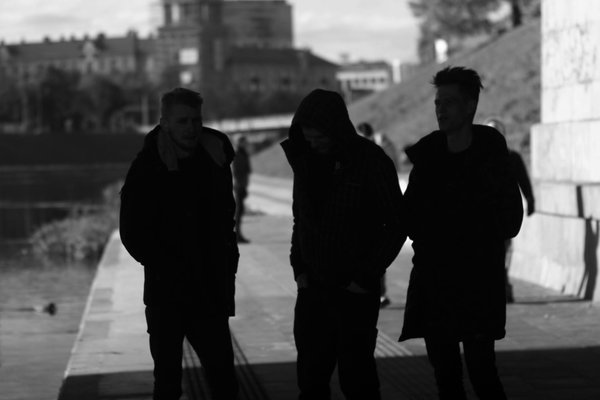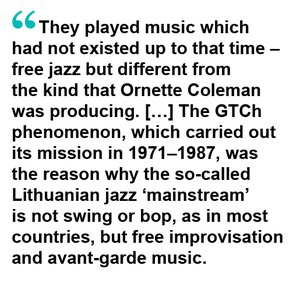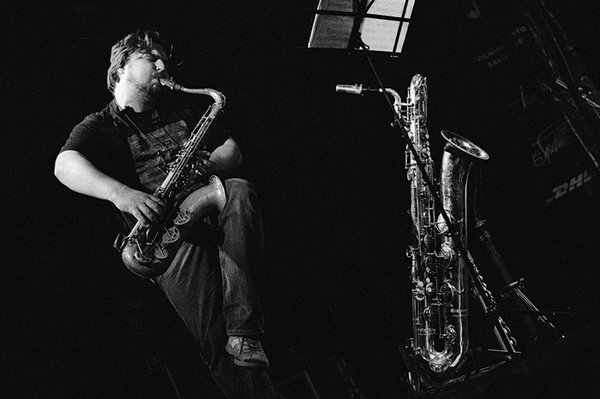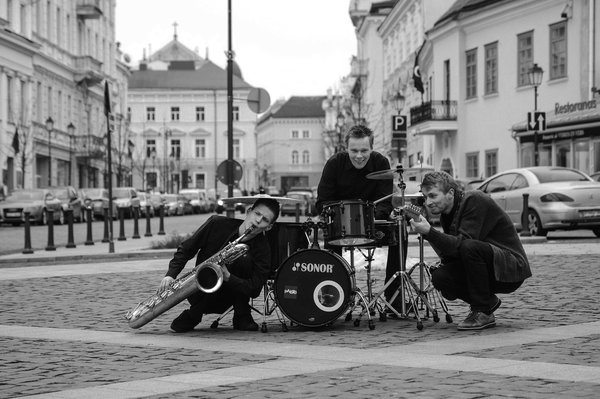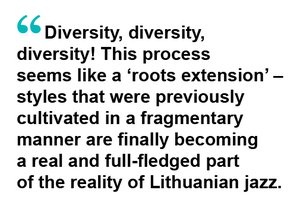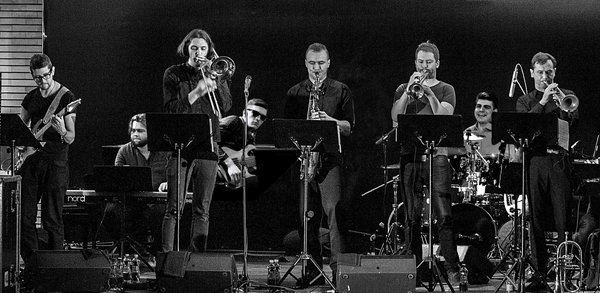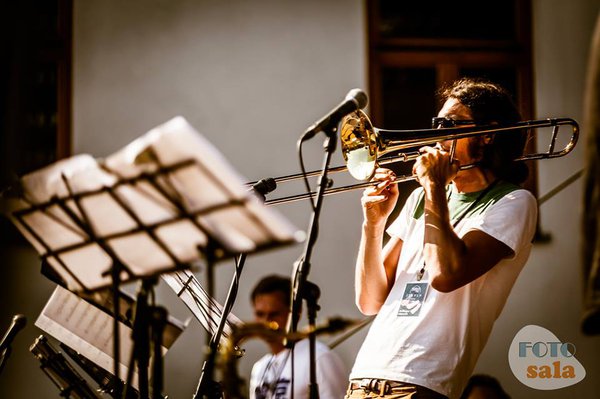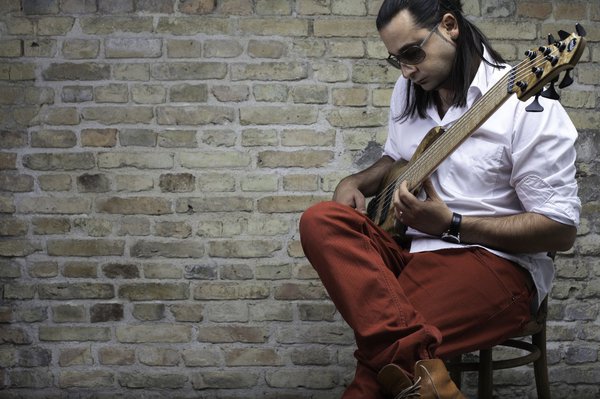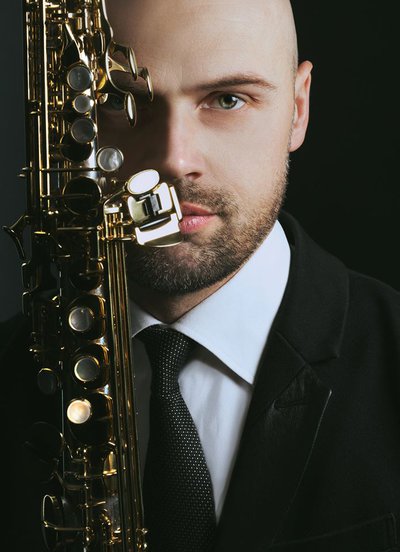Laima SLEPKOVAITĖ | The Cosmetology of Lithuanian Jazz: Roots Extensions
The time has come for new stories to be told. Not because the old one is inadequate or no longer relevant. In fact, the contrary is true: the old story is important, memorable and noble; it talks about a small, proud country with a strong sense of itself, in which the spark of hope smouldered during the period of oppression and occupation, and the sound that embodied it was jazz. Throughout the world jazz is the herald of freedom, so it is hardly surprising that Lithuania, hungry for new opportunities, unacceptive of the communist ideology that had been forced on it, opened itself up to this liberal, modern, personalised music and became another house for it to dwell in – a place in which yet one more unique and distinctive platform for improvisational creation could come into being.
The hierarchy of the USSR were absolutely right, in fact prophetic, in coming up with slogans like: ‘Today you are playing jazz and tomorrow you’ll be selling the Motherland.’ After all, if the ‘Motherland’ was a sham construct of 15 enslaved nations, the ones who played jazz were, in truth, those who destroyed it without the slightest feeling of remorse and fought first and foremost for the right to be autonomous, for people to have self-worth and not be tools of the system. Music, as history shows, is a powerful weapon, and an even more powerful weapon is good music. Perhaps jazz in Lithuania would not have reached as much political influence as it did if not for GTCh.
Acronyms were widely used in the Soviet environment. Every government body, every institution, commission, association and work group instead of having a clear name had combinations of two to seven words in their titles, and even more letters, which over time no one was able to decode, as if recognising the absurdity and facelessness of those nameless bureaucratic structures. And so it is ironic that in this sea of acronyms the acronym GTCh floated to the surface, one which did not denote some government body but three free persons, personalities, creators, i.e. entities considered to be the most dangerous to the ‘state’, namely Vyacheslav Ganelin, Vladimir Tarasov, and Vladimir Chekasin.They are not Lithuanians but their getting together in 1971 was one of the most amazing events in the history of Lithuania. They played music which had not existed up to that time – free jazz but different from the kind that Ornette Coleman was producing. They created a theatre of sounds, a humoresque, chamber jazz symphonies and multi-genre, audacious metamorphoses. And all of that – not in some marginal group, not in some cellar, but on the stage of the concert hall of the Lithuanian State Philharmonic Society (today the Lithuanian National Philharmonic Society), and not in some one-off experiment, but in the work-day routine of a full-time ensemble of aforementioned Philharmonic Society. Yes, the Ganelin, Tarasov and Chekasin trio worked in the Philharmonic Symphony Orchestra and officially represented the USSR in the USA and other countries in the West. This was a cult ensemble and to enjoy their work was considered to be cooler than to grow one’s hair long and dance in rock concerts.
The GTCh phenomenon, which carried out its mission in 1971–1987, was the reason why the so-called Lithuanian jazz ‘mainstream’ is not swing or bop, as in most countries, but free improvisation and avant-garde music. The local jazz world could be depicted graphically as standing on three whales (titans), leaning on them, growing out of them and still feeding on the inspiration generated by them… In using the term ‘mainstream’, I do wish to mislead the reader, who may think that the free jazz audience in Lithuania is exceptionally numerous. Most probably that is not the case. But there are other characteristics allowing one to distinguish avant-garde tendencies as ‘mainstream’. Firstly, even though the audience for this style of music is not massive, it is quite large enough to fill the Vilnius Jazz Festival halls every year with music to satisfy gourmets and orientated to bold innovative creative work. Following on from that, the VMU (Vytautas Magnus University) Jazz Connections Festival managed to bring together lovers of this kind of music. Single concerts with music of a similar kind are also put on at other festivals and their success is no doubt. Thus, in Lithuania free jazz and other varieties of jazz close to it have a sufficiently large and well-prepared audience.Secondly, the record company NoBusiness Records, based in Vilnius, has been in business since 2008. Their catalogue boasts world-class personalities in the field of modern improvisational music, like, for example, Joe McPhee, Martin Küchen, Mats Gustafsson, etc. Their classy output, most of it in the form of vinyl records, is aimed at the ears of connoisseurs. One can always find their records in Vilnius at the Thelonious music cellar (which was where the idea for the record company was born). However, the output is aimed at the world market – at the small group of music lovers, one could almost call them sects, who value uniqueness in musical expression. By the way, only a very small number of Lithuania’s musicians manage to satisfy the quality bar set by NoBusiness Records. So far the only musicians in Lithuania to have their recordings regularly released by the company are Liudas Mockūnas and Vladimir Tarasov.
And the third feature allowing us to assert that free jazz in fact is the Lithuanian mainstream is that musicians playing in this style have received the most recognition and most often represent Lithuania abroad. Petras Vyšniauskas, Liudas Mockūnas, Jan Maksimowicz, Juozas Milašius, Neda Malūnavičiūtė, Vytautas Labutis, Vytis Nivinskas are only some of the names on the list that spring to mind. Even Dainius Pulauskas, who plays classical, diligently composed jazz-rock, from time to time plunges into experiments where there is plenty of space for strange harmonies and flights of improvisation. Finally, the pianists Artūras Anusauskas and Egidijus Buožis, completely attached to the traditional lexicon of jazz, have in their histories at least one clear adventure in free jazz: for the first of them that happened when playing with Vladimir Chekasin, for the second – with Petras Vyšniauskas (that occasion has even been caught on a recording). Every wind player, every drummer or bassist has felt this sound in their bones (lungs, fingers), apart from perhaps the very young and those who consciously resist it (we are not aware of any such cases).
The younger generation, it would seem, is continuing this tradition in a consistent way and is upholding the dominance of the avant-garde sound. Juozas Kuraitis, Dmitrij Golovanov, Tadas Dešukas, the trio Sheep Got Waxed do not necessarily cultivate free improvisation in their music to the maximum. The compositional well-spring may not infrequently outweigh the spontaneous but this is the same aesthetic tendency and those who walk that path are not afraid of dissonance and speak in an expressive, refined and distinctive voice.So here it is – that Vilnius jazz, resting on the backs of three whales-titans… Here is the story which explains why the pianist Richardas Banys has so many strange modulations in his playing, and in a performance by at first glance the completely traditional Andrej Polevikov Quartet one can hear a solo by the bassist Vytis Nivinskas that is mystical, bewitching and breaks out of the box… But that does not explain why the unofficial collective that is the Vilnius Big Band gives prominence to the music of Jerome Kern and Richard Rodgers, why at international jazz festivals the sound of Lithuanian jazz is represented by the early swing group The Schwings, how Jievaras Jasinskis’ group Reinless, reminding us more of Snarky Puppy than GTCh, came into being, and a whole host of other examples. If we were to try to fit them into the ‘jazz on the backs of three titans’ scheme, they would remain flying somewhere around that construction, without any connection to that great legend of Lithuanian jazz. They all have some sort of relationship with GTCh but that most certainly does not mean that it is the direct source of inspiration!
So the time has come to relate other stories. It is not that they have never been told (the musicologists Jūratė Kučinskaitė, Rūta Skudienė and the pianist Oleg Molokoedov have related them) but they have never been as important as they are today.After all, the history of jazz in Lithuania did not begin in 1971. In Lithuania, like in all of Europe, the new trends of American jazz took hold in the 1920s, trends which began to penetrate the local form of popular music (estrada) under a different, adapted form, without the swing being expressed quite so markedly, without the harmonies typical of blues, but in spite of that, the influence was experienced, accepted and this new genre began to take root. War and the occupations, without a doubt, cut off the free flow of ideas and influences, but Lithuania in this regard was not an exception. Not only all those states that found themselves imprisoned in the USSR (including Russia itself) but also Poland, Czechoslovakia, Hungary and the other countries infected by communism experienced the same cultural separation, under which jazz became a forbidden fruit. On the one hand, this status was partially favourable since it was thanks to it that this music became imbued with such great authority and political or oppositional significance, on the other hand, it was completely unfavourable since musicians driven by their enthusiasm were not only short of information and the conditions to improve but were also unable to create without interference.
So, the traditional styles of jazz have been heard in Lithuania from the 1920s; they were heard in the interwar period, during the Soviet era and later. But up till then the music being played very rarely reached a level that could represent the local scene abroad. Right up to the start of the new millennium this was the privilege of those continuing the avant-garde line. Step-by-step, Lithuanians studied the fundamentals of American jazz, without having the historical conditions that France, Scandinavia or Great Britain had, since they were able to have the American jazz giants play there at a time when the Iron Curtain closed us off. The consequences of that Curtain are still felt up to this day (in the field of jazz as well) but currently we are witnessing an unusually active, previously unheard of range of different styles and most certainly not just in terms of quantity. The elegant ensemble The Ditties are reviving the repertoire of The Boswell Sisters and The Andrews Sisters but also have serious intentions to arrange the songs of Antanas Šabaniauskas using a tight three-part vocal harmony. Dominykas Vyšniauskas, the son of the famous representative of free jazz Petras Vyšniauskas, who seems to be inclined towards original creative work taking in ethnic elements and electronic music, unexpectedly joined the international project The Secret Swing Society and plays enjoyable Dixieland music on his trumpet. Andrej Polevikov is developing the concept of an ethno-jazz project. Pranas Kentra, who had earlier immersed himself in the cross-fertilization of Lithuanian and Balkan folklore music, has recently recorded an album of original, refined new fusion-type music. Domas Aleksa is immersing himself in a sea of modified sounds, spoken word, hard rhythms, and other discoveries. Kęstutis Vaiginis, the ‘local boy who made good in New York’, periodically puts on concerts with musicians like Alex Sipiagin or David Berkman and that is a strong collaboration based on mutual sympathy and an equal musical friendship. Liutauras Janušaitis, who improved his skills at Berklee College of Music, gets the Kaunas Big Band he leads to take on innovative, original projects of music by Lithuanian composers. Simona Minns, the third Berklee graduate from Lithuania, successfully creates her wonderfully crazy projects on the international arena. The husband and wife duet Soul Moustaches (Sielos ūsai) revives and transforms the shape of original songs. Dozens of talented performers, soon to become famous and shine bright, are studying at the Lithuanian Academy of Music and Theatre, the Jazz Department of Klaipėda University, in The Hague, Amsterdam, Denmark, Boston – we can no longer encompass the constantly increasing number of places on the map where our young people are studying. So many international projects! What a fast interchange of ideas!Diversity, diversity, diversity! This process seems like a ‘roots extension’ – styles that were previously cultivated in a fragmentary manner are finally becoming a real and full-fledged part of the reality of Lithuanian jazz. Styles that are new (for example, that of the group Reinless) create their equivalents on the local scene. Styles that are unique and only local find their space and listeners. As it happens, it is now that the result of open borders, a good training and accessibility is being felt. The Lithuanian jazz scene appears to be in flux and it is hard at this time to predict what it will be like in several years’ time. One can expect it to continue to grow and flourish, to become more international and to fill international festivals with its thrilling and intriguing sounds.
International festivals are the main form of jazz existence in Lithuania. This is not an ideal situation. In spite of the fact that the festivals are, it hardly needs saying, of a high level, well-attended and eagerly awaited, they do not always make up for the deficiencies in the everyday life of jazz. This situation, by the way, is also changing but more about that a little later.
Lithuanian festivals are the big events in the jazz year with each of them having its own idea and purpose. Vilnius Jazz, as has already been mentioned, is an avant-garde festival at which the Vilnius jazz school (the tree grown on the backs of the GTCh titans), European new jazz, conceptual projects from the Far East (Japan, China, Taiwan), expressions of the New York downtown scene and local young musicians (in the form of competitions) are fittingly represented. The Birštonas Jazz Festival, the oldest event of its kind in Lithuania (going from 1980) and dedicated to national jazz in all its forms, takes place every two years. The Kaunas Jazz Festival, as old as Lithuanian Independence, was a symbol of open borders and new opportunities. It is a very wide-ranging festival: besides concerts of elite, fashionable music, one can also find a whole host of free outside events. The Festival is a democratic event on several levels. The Klaipėda Castle Jazz Festival is completely free with well-known, amazing musicians performing under an open sky. No one has managed to explain how that is possible but that is why Klaipėda has become known as the New Orleans of Lithuania, a town touched by the spirit of jazz. Vilnius Mama Jazz is the youngest in a series of big festivals (from 2002 on) and occupies an exceptional niche: it brings together mainly young people and has become a real centre for the exchange of ideas and news. Fresh and new performers coming to the fore from New York and the cities of Europe take a prominent place in its programme with a continuous creative hubbub outside the performance space. With the inclusion of a cycle of TV discussion programmes on jazz, as well as stands set up by various companies promoting jazz in the foyer of the concert space, Vilnius Mama Jazz has come to look like a real living forum for jazz. Besides this handful of five big festivals other smaller, but equally meaningful and enjoyable, festivals take place. To put on a festival in Lithuania is somewhat easier than to run a jazz club.Vilnius for many years had no jazz club. To be more accurate, almost every year the happy news went out that a club had come into being but after a year or two of weekly concerts for a very wide variety of circumstances (bankruptcy, complaints about noise from neighbours, dwindling enthusiasm and so on) the happy news was replaced with sad news and the capital once again was left to wait for another optimist to try again.
And this time as well, we do not wish to be so bold as to count our chickens but Jazz Cellar 11 is the most beautiful new jazz phenomenon in Lithuania, completely unlike previous attempts to set up jazz clubs but very similar to a real jazz club. It is completely normal. To everyone that stops by, it seems as if it has always been there (even though it only opened its doors in December 2015) and everything in it corresponds to the classical concept of such a place. A discrete classical interior (wooden furniture, black and white photographs, wind instruments and vinyl records for the décor), comfortable acoustics, a small L-shaped space and a very varied programme, encompassing the totality of Lithuanian jazz (and not just Lithuanian). This place is equally welcoming to both veterans like Vyacheslav Ganelin and young musicians still studying, as long as they have talent and a suitable programme. In short, Vilnius now has a completely normal jazz club and we are trying to come to terms with the miracle that it is.
The time has come to tell new stories but the time has not yet come to draw conclusions or prognosticate. It may be that the birth of a jazz club is a sign that the local scene has simply grown to the level where it can create an everyday ebullient, lively concert scene, capable of holding the interest of listeners, that the spectrum of styles has become sufficiently wide, and the listener – sufficiently sophisticated. But one needs the distance of time in order to be able to evaluate the processes in train at this time. And they really are happening – rapidly and intensively, stimulating an optimistic curiosity.
Translated from the Lithuanian by Romas Kinka
